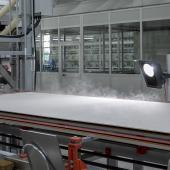World production and consumption of ceramic tiles: forecasts to 2028
The MECS Research Centre has published the new forecast report entitled Ceramic Tile Market Forecast Analysis: TRENDS 2024-2028. Tile production and demand are set to recover gradually over the next five years, with projected annual growth rates of +2.2% and +2.5%, respectively.
Luca Baraldi, MECS [email protected]

The fourth edition of the forecast report for the global ceramic tile market, published last November by the MECS-Acimac Research Centre, analyses production and consumption trends for the period 2024-2028, both by macro-areas and for 91 individual countries. The 238-page report concludes with summary tables ranking 90 producer and 146 consumer countries based on projected volume changes over the five-year period. Unsurprisingly, India tops the list for both production and consumption growth, while China sits at the bottom of the ranking with a negative outlook.
Methodology
As in previous editions, Ceramic Tile Market Forecast Analysis. TRENDS 2024-2028 is based on econometric models developed by MECS, integrating multiple quantitative indicators, including GDP trends, industrial and construction investments, demographic and urbanisation dynamics and household spending capacity. The analysis also factors in the impact of public policies, consumption patterns, sustainability trends and the state of logistics and infrastructure. This methodology allows a reliable projection to be made of the average annual growth rate for tile production and consumption over the period 2024-2028, even in the midst of significant structural shifts and global uncertainty. Ongoing geopolitical crises and the wars in Ukraine and the Middle East, coupled with potential policy shifts under a second Trump presidency, could reshape trade patterns and impact commercial relations with various countries and regions, including Europe.
World ceramic tile production
After a decidedly negative 2023 for the global ceramic tile industry (marked by a 5% drop in consumption and a 5.5% decline in production, equating to a loss of 1 billion square metres compared to 2022 and nearly 3 billion sqm less than in 2021), MECS forecasts a gradual recovery over the five-year period from 2024 to 2028. However, this rebound will not be sufficient to return to the record levels seen in 2021.
Global tile production is projected to grow at an average annual rate of +2.2%, increasing from 15.9 billion sqm in 2023 to over 17.8 billion sqm in 2028.
The key regions driving this recovery will be Africa, the Middle East (despite ongoing geopolitical uncertainty), non-EU European countries and the Americas, all of which are expected to grow at above-average rates. Africa, in particular, could see an annual increase of +5.6%, with production rising from 1.2 billion sqm in 2023 to 1.5 billion sqm in 2028.
The European Union is expected to expand in line with the global average (+2.2% per year), while Asia is projected to see a more modest annual growth rate of +1.6%. Asia’s overall performance will be significantly impacted by China’s ongoing real estate crisis, which is expected to drive a continued contraction in demand (-1.6% per year) and consequently production (-0.9%). Conversely, India is poised to acquire a growing share of global ceramic tile production, with output forecast to rise by an average of 5.9% per year through 2028. This corresponds to more than 800 million sqm of additional output over five years, nearly matching the projected growth in domestic demand of 778 million sqm.
World consumption set to grow by 2 billion sqm in five years
Over the five-year period, the global ceramic tile market is projected to expand by just over 2 billion sqm, an encouraging rebound compared to the past three years, though still below the rapid growth seen in previous periods. Global demand is expected to rise from 15.6 billion sqm in 2023 to 17.7 billion sqm in 2028, reflecting an average annual growth rate of +2.5%.
Africa is forecast to experience the highest growth, with an annual increase of +6%, followed by South America at +4.8% and non-EU European countries at +3%. In contrast, demand in other regions is expected to grow at a slower pace. The European Union, Asia and the Middle East will see annual growth rates ranging between +1.6% and +1.8%, indicating less dynamic market conditions in these areas.
Key emerging players
While Africa and South America will be the key regions to watch in terms of market growth, the leading players in the global ceramic industry are unlikely to change significantly. However, the MECS report highlights the emergence of new dynamic markets, particularly in Africa and Asia. Countries such as Bangladesh, Kenya and Kazakhstan are rapidly expanding their production, with annual double-digit growth projected until 2028. On the consumption side, these nations, along with Cameroon and Uganda, are also expected to see much faster growth in demand than global averages.
|
|
Production (million sq.m) |
Consumption (million sq.m) |
||||
|
area |
Production |
Production |
CAGR |
Consumption |
Consumption |
CAGR |
|
European Union |
1,039 |
1,157 |
+2.2% |
831 |
907 |
+1.8% |
|
Other Europe |
615 |
728 |
+3.4% |
636 |
737 |
+3.0% |
|
NAFTA |
349 |
403 |
+2.9% |
551 |
616 |
+2.2% |
|
South America |
1,124 |
1,282 |
+2.7% |
1,217 |
1,538 |
+4.8% |
|
Middle East |
859 |
1,033 |
+3.8% |
1,024 |
1,11 |
+1.6% |
|
Far East / Asia |
10,768 |
11,653 |
+1.6% |
9,896 |
10,814 |
+1.8% |
|
Africa |
1,178 |
1,545 |
+5.6% |
1,472 |
1,972 |
+6.0% |
|
TOTAL WORLD |
15,937 |
17,806 |
+2.2% |
15,627 |
17,693 |
+2.5% |
Did you find this article useful?
Join the CWW community to receive the most important news from the global ceramic industry every two weeks



 For info:
For info: 




















